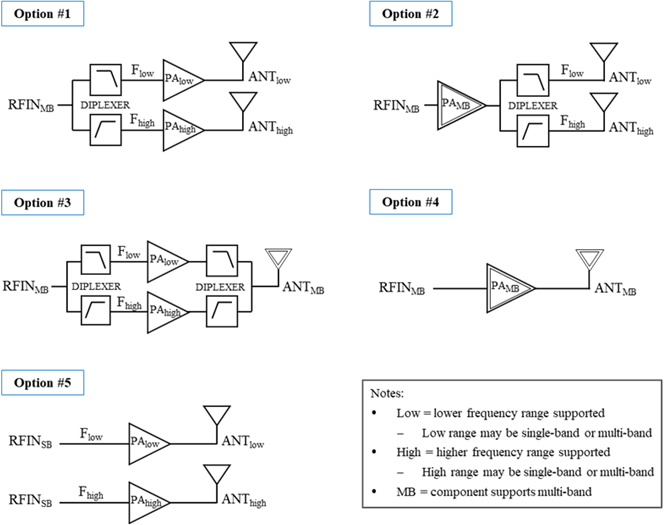Content for TR 38.877 Word version: 18.1.0
4 General p. 11
4.1 Study item objective p. 11
Study the following aspects for FR2 multi-band BS:
-
Example bands:
- 26+28 GHz: n258 + n261
- 28+39 GHz: n257/n261 + n260
- 26+40 GHz: n258 + n259/n262
- 28+40 GHz: n257/n261 + n259/n262
- Investigate the feasibility and performance of wideband RF and antenna architectures covering multiple FR2 bands
- Investigate if FR1 multi-band methods are re-usable for FR2, and (if so) agree on the appropriate inter-RF BW gaps
- Investigate if FR1 exceptions are acceptable for FR2
-
Investigate whether a generic solution for all combinations within FR2-1 is possible and/or a solution for all or a part of the frequency range should be targeted
- Frequency range 24-29 GHz which includes n257/n258/n261
- Frequency range 37-48 GHz which includes n260/n259/n262
- Study the definition of FR2 multi-band BS
4.2 Deployment scenarios p. 11
The scope of this study encompasses FR2 multi-band BS can support multiple FR2-1 mmWave bands transmission and/or reception through common active RF components. BS that supports multiple bands by means of separate antenna arrays and active components within the same enclosure are not in the scope of this study as they can already be supported by Rel-15 single band requirements and do not need further study.
FR2 BS capable of multi-band operation (whether those in the scope of this study, or BS supporting multiple bands by means of separate antenna arrays and active components within the same enclosure) should support evolution from single FR2-1 band to two FR2-1 bands application. Operators can configure for single band operation at one band initially and upgrade it to two bands sharing a common radio without further hardware investment.
Since common active RF components are used for FR2 multi-band BS, the receiver and transmitter operate simultaneously would require very large isolation, which make it less possible for unsynchronized operation between bands. Hence inter-band synchronized operation is required for multi-band operation.
Possible FR2 multi-band BS structures and configurations based on combining different receiver/transmitter implementations (multi-band or single band), as well as mapping receive and transmit signals on a shared antenna or separate antennas should be considered in the study.
Scenarios 1), 4), 5) and 6) below should be considered as the target scenarios to be studied in this study while no study needed on the scenario 2) and 3) below:
- Multi-band transmitter and/or receiver with common active RF components
- Single-band transmitter and receiver
- Configurable BS for different bands with the same hardware, i.e. only one band can be configured to operate at any time.
- BS covers full-band or sub-band of band A and band B
- BS covers consecutive spectrums with different band number, for example, n258+n261
- BS covers two bands which have overlapping spectrums, for example, n258+n257, and BS support no overlapping frequency range in the two bands.
4.2.1 Architecture options p. 12
Figure 4.2.1-1 depicts potential architectures based on the implementation options available for multi-band support in FR2-1 BS. The main components included are the PA, antenna array, and diplexers (wherever needed). Note that there are no active RF components before the RF input in any of the options in the Figure.

Figure 4.2.1-1: High-level architecture options to support multi-band operation in FR2-1
(⇒ copy of original 3GPP image)
(⇒ copy of original 3GPP image)
From the options captured in the Figure, Option #2 and Option #4 are the target scenarios of this study item, while no study is needed for Option #5. For Option #1 and Option #3, if the PA is capable of being operated in multiple bands at the same time, then it supports multi-band operation. However, if the PA can only be configured and operated in a single-band, then it is considered a single-band RIB.
Option #1 and Option #3 are feasible with current technology if the ranges covered by each path have a percentage bandwidth up to 19.5%. Per agreements in sub-Clause 5.2.1.4, Option #2 and Option #4 should also be feasible for a percentage bandwidth up to 19.5%. Note that even within the same frequency group, the performance attained would yield a lower Tx power compared to a single-band design. However, given that this requirement is a manufacturer declaration, it would not impact the requirement applicability.